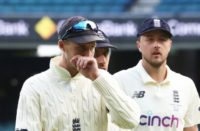Australia’s government has declared it will not do business with the UK until it has left the European Union but one company set to do a thriving trade with them irrespective of the Brexit timetable is Dukes, the cricket ball maker.
Exporting English cricket balls to Australia, to be used in place of their beloved Kookaburra, would be treasonable if it weren’t for the noble intention behind it – winning the Ashes on English soil.
Australia last achieved the feat in 2001 when Shane Warne still had his own hair, and teeth that did not light up a darkened room. But that is five Ashes series here without them spraying English cricket supporters with XXXX fizz – an interlude that has caused much brow beating and an inquiry, from which the use of Dukes cricket balls during the second half of their forthcoming season has arisen.
Giving the ball such prominence rather diminishes the old story of bowling schadenfreude – “that it is red and it is round”. Yet Australia’s think-tank reckon the Dukes ball has been a major factor in preventing their team from contesting those away Ashes series more closely, which is why it is being imported now so players can get used to its wiles in time for the next one here in 2019.
It looks like a classic bit of box ticking by those in roles created to leave no stone unturned in restoring greatness to the Baggy Green. Having watched Australia’s batsmen – all hard hands and macho intent – fish about for the Dukes ball last year, you can understand it.
And yet, the behaviour of a Dukes ball off a pitch like Trent Bridge, with Stuart Broad controlling the seam, is going to be a completely different experience to facing one at the WACA in February with Western Australia’s Andrew Tye sending it down.
For one thing, I hope Cricket Australia check which kind of Dukes ball they have. The best ones are hand-stitched and vary slightly from one another as a result, which is one of the reasons why some move about off the seam and through the air more than others. The company have, however, developed a high quality machine-stitched ball for harsher conditions, as found in Australia and South Africa, though that will not be the one used here in 2019.
Australia’s batting woes against the Dukes in England are mostly cultural. Brought up on pitches where the bounce is true and there is scarcely any seam movement except in the first ten overs, when the Kookaburra ball retains its hardness and bite to its seam, they get used to hitting through the ball on the top of its bounce.
Even defensive strokes are played with forcible intent – the hard hands mentioned previously.
It is a technique that works well when the ball’s movement is predictable but not when it moves late off the seam or through the air. Then, edges are found and because of the bat’s vigorous thrust, even in defence, they tend to carry. Remember the eight-wicket swathe Broad cut through Australia at Trent Bridge last summer when they were dismissed for 60? Each victim caught doing exactly as described above.
It won’t be the first time the Aussies have fussed about the cricket balls used in England. In 1989, Allan Border, who’d played county cricket for Essex the previous year, complained about the proposed use of the Reader ball, which most counties, or at least those where batsmen did not rule the roost, used due to its durability and unduly proud seam.
The Dukes ball was the alternative and Border, who discovered that England’s bowling attack had been using the Reader for the past two seasons, kicked up enough of a fuss that he and David Gower, England’s captain at the time, tossed for the right of preference.
They did all six Tests at once, Border winning the right to choose the ball for the first five (he chose the Dukes), Gower for the last one (the Reader). England lost the series 4-0, one of the two draws they achieved being with the Reader.
Many feel that the ball should be irrelevant yet there is a bewildering amount of variety even within the same brand. Most Test teams have ball pickers, tasked with choosing two balls from a batch of 12 from the umpires, the first being for immediate use, the second after 80 overs. Whether through bravado or confidence, the West Indies only ever picked one ball during the Eighties, but then they did possess the greatest pace attack in history and were certain few sides could withstand 80 overs of all-out assault from them.
When Graham Gooch was England captain, I often picked the ball. At the time, my preference, and that of the other bowlers, was for a small, dark ball with a strong pronounced seam. I’m not sure there was any scientific basis for those properties but that is what we liked and having asked James Anderson his preferences recently, they still pertain today.
Not everyone followed suit. Kapil Dev, at least according to the umpires who had callipers on hand to measure the balls’ circumferences, would always go for the biggest ball. His logic was that with ball beating bat more often than it found the edge, a bigger ball must increase the chances of finding that edge. He did take 434 Test wickets, so maybe he was on to something.
Unless this gives the Aussies the idea of ordering all the biggest Dukes balls, they are changing just one variable in the hope it will bring about a sea change in technique and approach among their batsmen. If it does, and I have my doubts, Dukes will be one export not in the national interest.
This piece originally featured in The Cricket Paper, October 28 2016
Subscribe to the digital edition of The Cricket Paper here












